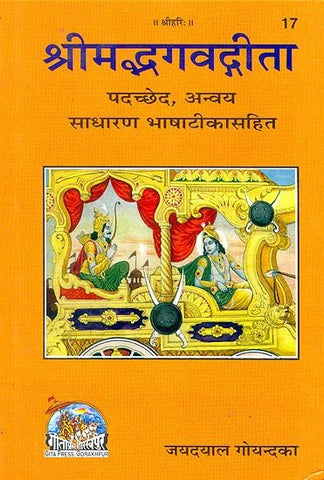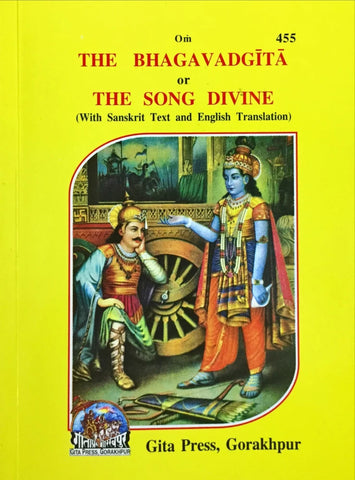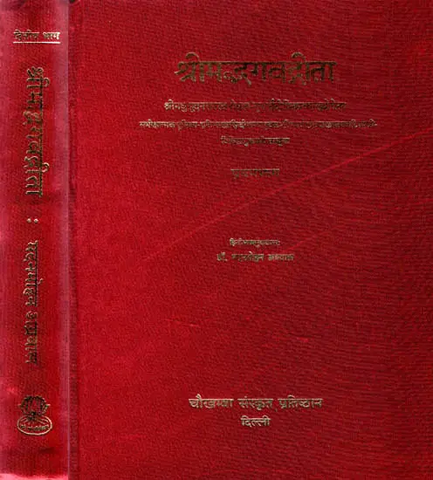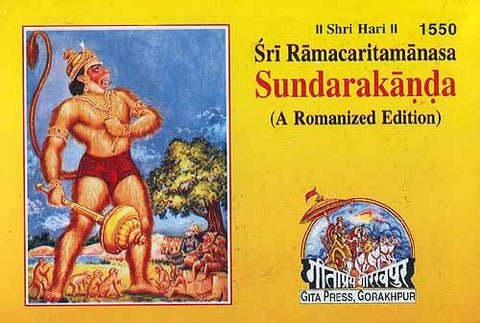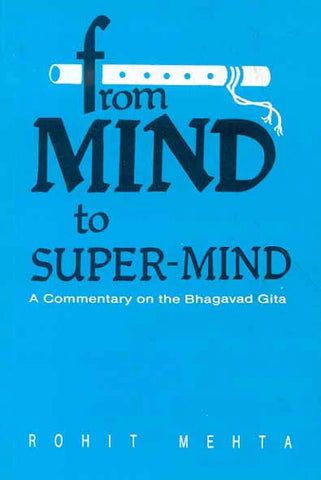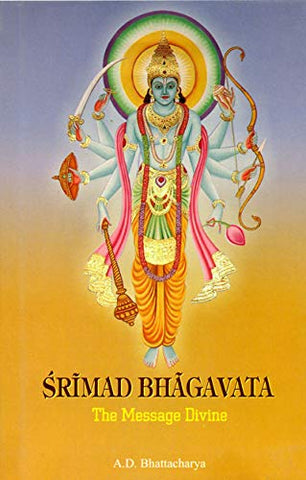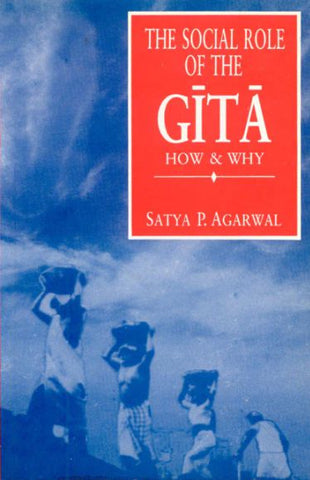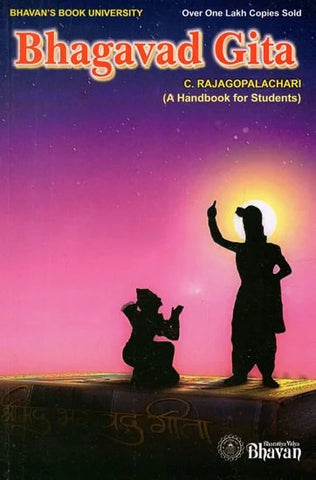Your cart is empty now.
Mrs. Duneja, a graduate from the Sanskrit University of Kurukshetra, is a well-known Vedic scholar and a devotee of Lord Krishna. She is the author of Hinduism: Scriptures and Practices, Mantra and the Modern Man, Bhagawad Geeta: The Gospel of Timeless Wisdom, and has also recorded several series of lectures on the science of yoga and meditation, the secret powers of mantra, and The Bhagawad Geeta.
The Geeta is an intimate dialogue between God and man. The God-incarnate is Lord Krsna and man is represented by the Mahabharata hero Arjuna. It is intimate because the esoteric wisdom imparted therein, says the Lord is “is more secret than secrecy itself’ (XVIII. 63).
A great battle is to ensue between the two royal clans of Kauravas and Pandavas. Arjuna requests Krsna, who is acting as his charioteer, to take him between the two standing armies so that he may have a look at those who have gathered to fight with him. There Arjuna is overcome with grief and refuses to raise his bow against his respected gurus and elders, and other kith and kin. At this critical juncture Lord Krsna explains to him what is right and what is wrong, and how by adhering to dharma a person can earn the highest virtue.
Every human heart is like a battlefield of good and evil forces. At times a person is not able to decide the right course of action. He is deluded and confused. When confronted with such a situation, he can turn to the Geeta; it will not fail him. The book therefore is of universal appeal which offers satisfactory solution to basic human problems. Whatever page you turn, and whichever verse you read, it is bound to elevate and inspire. It is not the book of a particular race or religion but the common heritage of the entire mankind.
The recurring emphasis in the Geeta is on the gospel of selfless unattached action, performed with perfect equanimity, and with full awareness of the Divinity within. The dialogue begins with the sorrowful lamentation of Arjuna. ‘O Lord, I know as a Ksatriya, it is my bounden duty to wage a righteous war but I would rather beg to earn a living than to acquire a Kingdom by killing my relations and disturb the focal point of so many families. A noble thought indeed. His difficulty was not to choose between dharma and adharma but between dharma and a still higher dharma as he perceived it.’
The general theme of the dialogue is the realization of the Supreme-Self through the constant practice of Yogic unity. Sri Krsna declares that those who strive, endowed with the spirit of selfless action, Yajna and Yoga, perceive the Lord dwelling in the self. Sri Krsna gives a definite promise of His grace in the words, “sarvadharman parityajya mamekam saranam vraja, aham tva sarvapapebhyo moksayisyami ma sucah”-resigning all the Dharmas, seek refuge in Me alone. I shall liberate you from all sins Grieve not.
Thus, the Geeta shows the path of attaining permanent peace and perfect bliss. The path is that of Yoga to be achieved through the performance of Yajna (selfless action). Yoga literally means ‘union’, a special type of union between the individual soul and the Supreme Soul. Yajna signifies sacrifice-briefly the offering of every little act at the altar of the Divine.
The Geeta recognizes that the peoples have different tendencies. Therefore it puts forward a number of ways to achieve Yoga-the mystic union. Broadly, there is Karmayoga, the Yoga of Action; Bhaktiyoga, the yoga Devotion and Jnanayoga, the Yoga of Knowledge. The paths seem to be different to suit different natures, but the goal is the same, to attain union with the Divine Spirit.
These are mixed concepts, therefore a number of commentaries on the Geeta have been written to explain the implications of various Yogas. Sri Adi Sankara emphasizes the knowledge aspect, while Shridhara prefers devotion and Bal Gangadhar Tilak is all for action to achieve the ultimate goal. There are other commentaries written by saints, sages and scholars.
To these has been added an elaborate and comprehensive commentary by Mrs. Prabha Duneja. It is a district contribution to the Geeta literature. She profusely draws upon the wisdom of Indian writers and relates their views with those of western thinkers like Aldous Huxley and Schumacher. This has been possible on account of her erudite scholarships of eastern and western philosophy, association with the Geeta since early childhood, and a passion for popularizing the message of the Geeta at religious workshops and Vedic satsangs.
The author is a strong advocate of the path of devotion.
Throughout her commentary there is a running refrain to remain in constant awareness of the Divine. It is only when a person is attached to God that he can be detached from the world and all his actions will be purified in the ‘fire’ of Yoga of Knowledge. Living in a state of “Perpetual connectedness” with the Indweller, she says, is far better than all the austerities, performance of rituals and scriptural knowledge. The author presents the concept of Yoga in a conspicuous manner. She has given a clear, concrete and comprehensive explanation of Yoga with her experiential knowledge, enlightened insight and authority.
In preface, the author has encapsulated the gist of each of the 18 chapters of the Geeta. The explanations of verse are elaborate and elegant and will also satisfy those who may not be quite familiar with the Indian ethos. Laced with inspiring anecdotes, it is a remarkable commentary which will enlighten the learned as well as the laymen, in India and also in foreign lands.
Bhagawad Geeta is the most luminous dialogue in the legacy of Vedic literature. The holy poem has been upheld as one of the Prasthana-traya-the three authoritative books of the Sanatan Vedic religion. The first one is the Vedic Prasthana called the Upanisads, the second is the philosophical Prasthana-the Brahma Sutra; the third Prasthana is the Bhagawad Geeta. These three holy books constitute the final authority on scriptural matters. Geeta is a unique scripture which summarizes almost all the essential teachings of the Vedic literature. It has been a perennial source of spiritual inspiration for the entire mankind. The message of the holy dialogue has been held in deep reverence by the sages, philosophers and learned scholars all over the world. The teachings of Geeta are universal, broad and sublime meant for the welfare of entire creation. Bhagawad Geeta is one of the most well-known and revered texts among the other scriptures of the world. It is a compendium of spiritual wisdom and the most appropriate guide for living a harmonious life in all respects. There are hundreds of commentaries on Bhagawad Geeta-both in Indian and in many foreign languages. This is perhaps the most widely translated scriptural text of the world. In the words of Dr. Radhakrishnan, “for centuries people have found comfort in this great book which sets forth in precise and penetrating words the essential principals of a spiritual religion which are not contingent on ill-founded facts, unscientific dogmas or arbitrary fancies. With a long history of spiritual power, it serves even today as a light to all who will receive illumination from the profundity of its wisdom which insists on a world wider and deeper than wars and revolutions can touch. It is a powerful shaping factor in the renewal of spiritual life and has secured an assured place among the world’s greatest scriptures.”
The message of the holy Geeta is indeed phenomenal and timeless. It is an anthology of spiritual wisdom which guides the individual into the mysteries of self-realization and God-relization. It analyses almost all the various levels of human psychology and trains the person into living a productive, joyful, balanced and creative life. The message of Geeta synthesizes almost all the well-known teachings of ancient scriptures of the world and it is addressed to the entire mankind. In the words of Dr. Annie Besant, “Among the priceless teachings that may be found in the great Hindu poem of the Mahabharata, there is none so rare and precious as this “The Lord’s Song”. Since it fell from the divine lips of Sri Krsna on the field of battle, and stilled the surging emotions of the disciple and friend, how many troubled hearts has it quietened and strengthened, how many weary souls has it led to Him! It is meant to lift the aspirant from the lower levels of renunciation, where objects are renounced, to the loftier heights where desires are dead, and where the Yogi dwells in calm and ceaseless contemplation while his body and mind are actively employed in discharging the duties that fall to his lot in life. That the spiritual man need not be a recluse, that union with divine life may be achieved and maintained in the midst of worldly affairs, that the obstacles to that union lie, not outside us, within us, such is the central lesson of the Bhagawad Geeta.”
The message of Geeta presents a profound insight into the working of human nature and provides the most appropriate guidance which is needed in almost every field of life in order to live in perfect harmony with our own self and with others. The dialogue provides an understanding into the mystery of the Supreme-soul and how every individual can restore himself to the Supremacy of his essential nature. Ever since the teachings of Geeta have become known to the people in Europe and America, it has quickly won the interest and admiration of millions. Many philosophical and religious groups in foreign countries hold the same respect for Geeta as the people in India. About the popularity of Geeta, Mahatma Gandhi has written that during one of his visits to England he went to a big library and inquired from the librarian about the most popular religious book which was in greatest demand. The librarian informed him that it was indeed the Bhagawad Geeta. Dr. Paul Brunton, a great British scholar, has written about the glory of Geeta in these words: “This ancient book can satisfy the modern needs. Nearly every literate yogi in India carries with him a small edition of this inspired and profound classic, the Bhagawad Geeta. If this gospel of contemplation combined with action had been understood in the land of its birth as it should be understood, India would today shed the radiance of her spiritual illumination to the far corners of the world and provide a masterly pattern of a balanced Material -spiritual existence for all other countries to witness. The Geeta summarizes various approaches to the Overself and also describes the latter. Sri Krsna not only represents the embodied spiritual teacher, He is ultimately the Overself within man, the God within who can illuminate all dark comers and answer all questions. At the end of the dialogue after hearing all the teachings, the pupil's mind becomes peaceful. He says indeed: "My doubts are dispelled. Destroyed are my illusions." By what magic was this mental change accomplished? Through both the guidance and grace received from his teacher and his own inner growth in striving for insight. The difficulties one meets in modem life can be met and overcome after we gain such insight. Wisdom means the ability to negotiate all the circumstances of life adequately, correctly and with spiritual success. The deep spiritual comfort emanating from the teachings of the Geeta is peculiarly needed at this stage of the world's affairs."
The great educationist and philosopher of India, Mr. Madan Mohan Malaviya, has written about Geeta in these words: "I believe that in all the living languages of the world, there is no book so full of true knowledge, and yet so handy as the Bhagawadgeeta". The well known professor of religion at Oxford University, Mr. Zaehner, has written about the glory of the sacred song in these words, "Geeta is a first-hand guide to the ancient roots of Vedic religion. Although in Shevatsara Upanisad the transcendence of the personal God has been affirmed to some extent-with Geeta has come the devotional religion". The great respect and appreciation for Geeta has been voiced by Warren Hastings, the first British Governor General of India, in year 1773. He has said, "The work as the Geeta would live long after the British Empire in India has ceased to exist". The Song Celestial by Sir Edwin Arnold describes the greatness of Geeta in these words, "In plain but noble language it unfolds a philosophical system which remains to this day the prevailing Brahmanic belief, blending as it does the doctrines of Kapila, Patanjali, and the Vedas. So lofty are many of its declarations, so sublime its aspirations, and so pure and tender is its piety". Sir Edwin Arnold has called Geeta the incomparable religious classic of India. Similarly, Mr. Von Humboldt, Maxmuller, Emerson, Franklin Edgerton and Aldous Huxley and many other scholars and educationists of the world have taken Geeta as a text for the exposition of their thoughts. In the words of Aldous Huxley, "Bhagawad Geeta is perhaps the most systematic spiritual statement of the perennial philosophy."
Srimad Bhagawad Geeta has been designated as Yoga Sastra. The word yoga has been derived from Sanskrit root word yuj which literally means to bind, combine and join together the psychic energies in order to experience a union' and communion with the indwelling Supreme-Self. It is an art which helps the individual to bring his scattered thoughts together into a reflective and meditative state of mind in order to comprehend the presence of the Divinity within. Yoga is the unity of the individual-soul (Jivatma) with the Supreme-Soul (Paramatma). The yogic practice helps the individual to accelerate himself to the state of consciousness in which his egoistic individuality is dissolved. It teaches the techniques of directing the attention from the gross body to the nerves and the senses; from the senses to the mind and from the mind to the intellect and the Supreme-Self. Philosophically, Yoga means union with the Supreme-spirit. The ancient scriptures describe Yoga-chitvriti-nirodha-means yoga is to control all the mental modifications. It is an art which persuades an incoherent and scattered mind into a reflective and coherent state. The Yoga system was first collated and written down by the sage Patanjali in his Yoga Sutra which consists of one hundred and ninety-five sutras divided into four chapters. The first part deals with the theory of Yoga; the second part describes the art of Yoga and the initiation into practice. The third illustrates the method of comprehending the inherent powers and the fourth deals with inner unity and freedom from the identification with the physical body. The Yoga Sutra of Patanjali also describes the eight steps of self-discipline which prepare the individuals for the ultimate experience of union and communion with the Supreme-Self. Yoga practice is not only a means to a certain end, it is indeed both the means and the end.
The eight steps of yogic discipline are-Yama, Niyama, Asana, Pranayama, Pratyhara, Dharna, Dhyana and Samadhi. In Geeta Sastra Sri Krsna has given a vivid illustration of all these Mahavratas during his conversation with Arjuna. For example, the practice of yama which stands for the collective, universal and moral commandments like non-violence, truth, continence and non-stealing has been described at length in chapters thirteen, sixteen and seventeen. The practice of these Mahavratas in daily life accelerates and purifies the day-to-day emotions of the individual towards the pursuit of higher goals in life. The Niyamas are the rules adopted by the aspirants for self-purification. These include the various types of austerities and the study of scriptures which has been described in Geeta chapters third, fourth, fifth, sixth, sixteenth and eighteenth.
The next steps in Yogasutra are Asanas and Pranayama. Asanas are the physical exercises which purify the body and tune the senses of perception, action and mind into developing a unity with the indwelling-soul. The appropriate posture in yogic meditation helps the individual to eliminate the harmful toxins from the body and make the embodied-self more receptive to the voice of the inner-Self. Pranayama means a conscious control of breath. It is an act of rhythmic inhalation, retention and exhalation. In order to attain mastery in yogic communion, Pranayama plays a significant role. It is an art of breathing which helps the aspirant to monitor his quality, quantity and direction of thoughts. The necessity of the accurate posture in meditation and also the techniques of Pranayama have been described in chapter six from verses ten to fifteen in Bhagawad Geeta. The next step in yogic meditation is pratyahara meaning a conscious control of the senses which has been emphasized by Sri Krsna throughout his dialogue. The other three steps are Dharna, Dhyana and Samadhi. Dharna is one pointed concentration with faith and determination. It integrates the thinking faculty and helps the individual to move into the serenity of Dhyana which means settled contemplation. In the meditative state of Dhyana the aspirant remains aware of the body, breath and mind; in Samadhi the outer consciousness starts fading and a blissful state of inner tranquillity is experienced. It is the method of rising to the state of consciousness wherein the egoistic individuality is dissolved and the embodied-self resumes his unity with the Supreme-Self. Samadhi is deep meditation; it is a blissful experience of yogic communion and unity with the indwelling-Self.
Srimad Bhagawad Geeta has been designated as the Yoga Sastra because it explains the theoretical knowledge of the Supreme-Soul and also the techniques to perceive and experience that Absolute Reality. The sage Ved Vyasa has declared Geeta Shastra midam punyam yah pathet prayat puman vishnoh padam vapnoti bhaya shoka divarjitah- anyone who is genuinely devoted to the study of Geeta Sastra, he is liberated from all types of fears and sorrows; and attains the Supreme abode of Lord Vishnu. In words of Dr. Radhakrishnan, "The Geeta gives a comprehensive Yoga-Sastra, large, flexible and manysided which includes various phases of the soul's development and ascent into the Divine. The different yogas are special applications of the inner discipline which leads to the liberation of the soul and a new understanding of the unity and meaning of mankind. Everything that is related to this discipline is called a yoga such as Jnana-yoga or the way of knowledge, Bhakti-yoga or the way of devotion, karma-yoga or the way of action." The concept of Yoga as described in Geeta Sastra is very vast, subtle and broad. Here the aspirant is initiated to live his entire life in the awareness of the Divine and perform all his duties through the perpetual guidance of unity in Yoga. It is to live a life which is firmly grounded in eternal union with the Supreme-Soul and to work with the consciousness of the indwelling-self.
Nitya-yoga of Geeta is the perpetual unity with the absolute Divinity. Sri Krsna has used many expressions in order to explain the subtle meaning of yoga such as Nityayoga, Samatvayoga, Buddhiyoga, Karmayoga, Bhaktiyoga, Jnanayoga, Rajayoga, Jaapyoga, Karmasanyasyoga, Abhyasyoga, and Dhyanyoga etc. The aim of Geeta Sastra is to initiate the individual into a life of yogic unity with the Supreme-soul, which upholds, supports and guides mankind into a higher, systematic, peaceful, creative, productive, joyous and balanced lifestyle irrespective of nationality, race, class and faith. In the words of Mahadev Desai, "Arjuna too had probably heard of yoga before, but he now finds it presented to him in a new light. If yoga means the forgetting of all fruit, all attachment, then it means detaching oneself from the lower self and identification with the Supreme Self. One has to disjoin oneself from the impermanent to join oneself to the Permanent. But so long as the Self is encased in the impermanent tabernacle, one cannot disjoin oneself from it, except by purifying it, spiritualizing it, by making the not-Self work in tune with the Self. Yoga is thus both means and end". Yoga of Bhagawad Geeta is to live in unity with the Supreme-soul and work in unity with the Supreme- soul. The verses such as tasmat sarvesu kalesu mam anusmara yudha ca and mayy arpitamanobuddhir mam evai syasy asamsayah mean therefore at all times remember Me and fight; with your mind and reason thus absorbed in Me, thou shalt surely come to Me.
The Yoga of Geeta demands the most sacred form of discipline, the toughest, purest and the highest form of discipline which is nurtured by living in the constant awareness of the Divine. The message of Geeta declares that the unity in Yoga is not merely a practice in isolation; it is the discipline of living in the consciousness of the Self. It is the manifestation of inner unity in every day life, it is a transcendental experience and also the ability to act efficiently in the world. The yogic unity with the indweller can be practised at almost each and every station of life-in office, at home, with family, while walking and while performing the most serious duties in the world. The yogic communion is to learn to live into the higher dimension of life and pursue each and every activity in unity with the indweller. It is the experience of living in Bliss which comes to the individual with a disciplined daily practice and grows in intensity from moment to moment. In the words of Swami Chinmayananda, "In all Hindu philosophies there are two distinct sections: one explaining the theory and the other describing the technique of practice. The portion that explains the technique of living the philosophy and coming to a close subjective experience is called the Yoga Sastra. Since the Geeta is called a Yoga Sastra, we must expect to discover in the Song of the Lord, not only airy philosophical expositions of a Truth too subtle for the ordinary man to grasp, but also instructions by which every one of us can, from this present state of imperfection, hope to reach, step by step, the giddy heights of the Divine pinnacles, that stand eternally swathed in the transcendental glory of Absolute Perfection".
The Geeta Sastra comprises seven hundred Sanskrit verses divided into eighteen chapters. Each chapter has been designated as a specific type of Yoga. The most luminous dialogue in Bhagawad Geeta opens with Vishad Yoga or the yoga of despondency. Vishad means deep sorrow, pain and despondency when the individual mind sinks in delusion, distress, dejection, depression, emotional conflicts and loneliness. Yoga means union with the indwelling-self. Vishad Yoga- means the unification of the individual soul with the Supreme-soul in moments of deep depression and dejection. Despondency is the dejected state of mind when everything in life appears to be unsettled, emotionally confused, fragmented and disintegrated. In moments of loneliness, when the individual soul feels helpless and depressed; he is persuaded to seek help from the over-self and take refuge in the realm of the Supreme-soul. It is indeed a fact that when the person feels dejected and cries out from the depth of his heart, the help is felt within the ever renewing current of life. Every individual has to experience the depth of vishad (depression) in order to experience the Bliss of prasad (grace). He has to pass through and cross over the self-created egocentric circles in order to be receptive to the love and blessings of the indwelling-self. The experience of inner unity purifies the individual and clears his mind from all kinds of emotional conflicts. It restores the embodied-self to the clarity of illuminated understanding and inner quietude. Any painful or serious and traumatic experience of life brings internal guidance which helps the individual to release the painful past and move on in life with a renewed concept of truth. In the experience of inner unison when the individual resorts to the benevolence of the indwelling Supreme-soul the veil of his egocentric thoughts disperses and disseminates momentarily and the person becomes receptive to the voice of the Supreme-Self. An honest surrender of the individual soul to the benevolence of the Supreme- soul in pain, honesty and innocence is indeed the Vishadyoga. In the words of Swami Tapasyananda, "the first chapter depicting Arjuna's grief is meant to show under what conditions a man opens himself to the voice of the spirit. A crisis is often required to make him turn his eyes to the spiritual reality. Often it is the impact of death, loss, disease, faithlessness of man or any other such bitter experience of life that causes the awakening".
The second chapter has been entitled the Samkhya Yoga meaning the yoga of the transcendental knowledge or communion through transcendental knowledge. The second discourse is very enlightening in which Sri Krsna declares the immortality of soul and also introduces to Arjuna the most reverend doctrine of the gospel of selfless action. In this chapter Sri Krsna explains to Arjuna some of the most useful aspects of Samkhya philosophy. The samkhya concept has been brought down to us by the ancient sages of vedic religion. Samkhya philosophy, as the name itself is self-explanatory, is an analytical study of the matter, mind and the Supreme-Soul. In the analytical process of samkhya knowledge, every aspect of learning goes through some hypothesis, formulas and conclusion. Almost all the sciences of modern world have originated from the Samkhya philosophy. It is experimental and also the experiential knowledge of the Supreme- Soul. In this chapter Sri Krsna tells Arjuna that there is one unchanging reality that pervades the entire universe. It is the Supreme consciousness, the Supreme-Soul and the essential being of everyone and everything. He draws Arjuna's attention towards the comprehension of the essential difference between the sat and asat- existent and nonexistent, real and unreal. The real always remains the same while the unreal changes every moment. Everything which is seen manifested in the world, it comes into existence; it is sustained for a while and then it perishes. The changing world is pervaded by the unchanging reality-the Supreme-Soul. He tells Arjuna that the wise sage who remains firmly grounded in the consciousness of the Divine, he has the experiential knowledge of both existent and non- existent.
Sri Krsna explains Arjuna that the indwelling-soul is eternal, non- changing, imperishable and immutable. The soul of everyone existed in the past, is existing in the present and will exist in the future. The embodied-self changes merely the form and shape. The embodied-soul goes from one body to another; forced by the residual impressions which have been accumulated during the lifetime. The individual-soul retains its individuality from one stage to another and also from one life to another. The destruction of the gross body can never cause any destruction in the continuity of the indestructible soul. There is a mantra in Rig Veda which explains this truth: yatha purva makal divim cha prithavi chantariksha mayo-everything comes into existence just as before. He tells Arjuna that there is nothing in the world which becomes totally lost and loses its essentiality. Everything continues to exist in one or the other form. The entire universe is constantly evolving. It is only the spiritual insight which helps the individual to understand the continuity of life from the past-through the present and into the future. The person who remains grounded in the truth of the deepest awareness, to him the transmigration of the soul is merely like changing garments.
The chapter three has been entitled Karmayoga which is communion with the indwelling-soul through the performance of work. The word Yoga means a union and communion with the indweller; so Karmayoga literally means the type of actions, those help the individual to develop a union with God. Karmayoga is the art of living and acting through the uninterrupted consciousness of the Supreme- soul. As a matter of fact, the action itself becomes its reward when it is performed intelligently, diligently and devotedly. The discipline of Yoga is a practice of living in constant unity with the Supreme-soul. This inner discipline and inner unity transforms the psychological level of the individual and makes him receptive to the voice of the Supreme Lord within. The unity initiates the individual into self-surrender, self- realization and God-realization. It is the consciousness of the yogic unity which eventually transforms the performance of every activity into the yoga of action. Sri Krsna assures Arjuna that even the highest achievement of transcendental unity is possible through the yoga of action because in this discipline the individual works in constant communion with the Divine. The constant practice of yogic unity in the performance of action enables the person to discover his sublime centre of ever luminous consciousness within his own self. When he becomes settled in that field of awareness, the concept of unity becomes his abiding heritage under all circumstances. It is a well known fact that the highest goal of life can be realized, when the person is unassailably established in yogic unity and when he himself becomes aware of the truth that he is living in it. Living a life in the consciousness of the Divine, and performing all work with the consciousness of the Divine is Karmayoga. It is the realization of God through the performance of actions.
Anyone who performs work with unity in yoga, he is eventually released from the bonds of birth-death and rebirth. He attains to the blissful state of immortality. In this chapter Sri Krsna has explained the term yajna with its expanded meaning and contents. He presents the subtle meaning of yajna with reference to the mutual interaction, of activities. Yajna, a well known religious term of the vedic tradition literally means the act which helps the individual to live in harmony with everybody and everything. The performance of yajna is to perform all the activities as a worship and as an offering to the Supreme. Yajna transforms all work into yoga. The spirit of yajna conveys the idea of interdependence, continuity and the survival of the creation. It is the network of the services performed selflessly by human beings, gods and mother Nature. Sri Krsna illustrates the process of God-realization through the work which is performed as yajna (sacrifice). Sri Krsna suggests that every activity becomes a cause of bondage unless it is performed with the spirit of yajna meaning the ideology of swadharma. Sri Krsna makes it more clear in verse eleven by declaring "fostering each other disinterestedly and by supporting each other with the spirit of yajna, one can attain the highest good in life". It is indeed the performance of every activity with the spirit of yajna which helps the individual to accomplish the highest goal of attaining unity in yoga. Sri Krsna tells Arjuna that it is the duty of every individual to respect the spirit of sacrifice (yajna) which makes the life prosperous, auspicious, harmonious and peaceful. He says that the person who lives only for himself and holds his own selfish interests upfront, who accumulates wealth only for his sensual enjoyments, depriving others of their due share, he lives a sinful life. Yajna is an expression of virtue, purity, kindness, giving and sharing. In order to understand the meaning of ethical harmonious living, it is very important to understand the definition of yajna. In the words of B.G. Tilak, "The message of Geeta, that the individual's whole life should be turned into yajna, contains the essence of the entire Vedic religion". The spirit of yajna creates harmony in the entire universe. The performance of work in the spirit of yajna helps people to understand the ideals of selfless action.
In chapter four, Sri Krsna declares that the revolutionary concept of Karmayoga is not new; it has been taught to the Vivasvan (sun- god) at the beginning of creation and later it has been imparted to Manu and the king lkshavaku the first ruler of the sun dynasty. He tells Arjuna that the royal sages have been very well acquainted with the yoga of selfless action. This chapter has been entitled jnana-karma- yoga-the Yoga of Action through Knowledge. It explains the union and communion with the indwelling Supreme-Self through the proper knowledge of performing actions. The nature of Karmayoga has been discussed from various angles and the importance of proper knowledge has been emphasized in the performance of action. It explains the philosophy about the nature of actions and also the wisdom which initiates the person into the practice of Karmayoga. Sri Krsna tells Arjuna that the yoga of selfless action is not a new concept. This discipline of action came with the creation and it has always existed since the time immemorial. It is the perennial wisdom which has assisted the sustenance of life in this universe in all respects. The whole creation functions through the spirit of mutual exchange. It is a network of services performed selflessly.
In this chapter Sri Krsna announces that whenever there is a decline of Dharma and the rise of Adharma, I manifest myself in order to re-establish the values of righteousness and to protect the virtuous people. The word Dharma derives its root from the word Dhar meaning to uphold and maintain. Dharma means the code of conduct which is supported by the voice of the inner-self. Sri Krsna is declaring in these verses that whenever there is a decline of righteousness, moral values, I manifest Myself as God-incarnate, in order to uphold the righteousness and to restore the orderliness on earth. Dharma is a unique system of values which is determined by the inner-self; which guide the individual to perform his duty by keeping in mind the welfare of others. Dharma is the golden message of God, "treat others as you would like to be treated by them". It is a guidance from the Higher-self; devoid of all the external pressures from society. It is an inner awakening that enlightens the person to differentiate between the desirable and undesirable acts. Swadharma is the experiential realization of the Supreme-soul. Any activity which is carried on with the awareness of the indwelling light it becomes a source of peace for everybody, because in that lies the manifestation of God Himself. Any duty performed in this manner protects the rights of others and implies to the general well-being. So any type of dealing one undertakes and the advancement one proposes it should be in consideration to the well-being of others.
In any society where people become very materialistic, the existential fear increases. When each individual is led single-mindedly, in the pursuit of wealth, the spirituality is usually pushed to the very far end. With the negligence of spiritual values people become selfish, self-centred and ignore swadharma. When the feeling of jealousy, greed, envy and peer pressure of every kind increases in society, there comes the distortion of moral values, restlessness of mind and decline in ethics everywhere. Any type of material progress and happiness which is preferred over ethics, becomes another form of misery. Accepting the presence of the Divine and performing every bit of work with the guidance of the Divine is Dharma; on the other hand, conscious separation from the Divine and living a life against the voice of the Supreme-soul is Adharma. Dharma brings people together while Adhanna disintegrates. The decline of Dharma (righteousness) starts at the individual level and gradually spreads throughout the community and nation causing a downfall of the entire human race. Decline of Dharma is the decline of morality, virtuosity and spiritual values everywhere. The decline of spiritual and moral standards generally happens due to the loss of self-respect and due to the loss of respect for God. The lack of faith in one's own self is also due to lack of faith in God. When people lose their conscious touch with God, they lose touch with themselves and with everybody and everything around. People become very insensitive, selfish, corrupt and self-centred. This is what Sri Krsna means to say in the verse seven-Whenever there is the decline of righteousness and the rise of unrighteousness, O' Bharata, then I incarnate Myself; for the protection of the virtuous, for the destruction of the wicked and for the re-establishment of the righteousness.
Sri Krsna enlightens Arjuna that the world is a vast field of mixed actions. People driven by their innate nature choose the kind of work that suits their liking and aspirations. These innate inclinations of people have brought into existence the fourfold work-order in society. The word caste is self-explanatory; it means the role one has been assigned to play in his lifetime. Although all men look alike on the surface, yet their intellectual and physical abilities do differ from one another in so many different ways. People have always divided themselves into four different classes. The people in each class have always performed their duties, guided by their svabhava (innate nature). Even today we can observe this division of work in almost all the developed cultures of the world. For example, the teachers, philosophers, scholars form the first; the second one is administrators, managers, leaders, soldiers; and the third class is businessmen, industrialists whereas the fourth is workers, servants and the labourers. The caste system has been based on the swabhava meaning the inborn nature which is expressed in the type of work one chooses to perform. The self-imposed classification of people in the society has always helped the community in the proper distribution of work according to the innate choice of every man. In the words of Swami B.V. Tripurari, “This social structure is called varnashrama. The Sanskrit word varna literally means 'colour', but it refers to the 'color' of the mind, or one's temperament, and not to the body. It therefore implies a standard of conduct or mode of occupation that naturally corresponds with one's mental disposition or karmic tendency. The varnashrama social system divides human effort into four classes of occupation by determining one's karmic leaning, not by what family one takes birth in. It first takes into consideration one's spiritual status and then determines one's material propensity".
In this chapter Sri Krsna has emphasized that all types of spiritual services and the yajnas become beneficial only if performed with proper insight. These purificatory actions become the means of liberation, if co-ordinated with the knowledge of the Self. Therefore each and everyone who seeks emancipation and peace in the present life, must make appropriate efforts to illuminate the understanding which can enlighten the process of performing actions. He declares that there is nothing else in the world which can equal the purifying power of the transcendental wisdom. The individual, who is settled in yogic communion, experiences it in due time. As a matter of fact, the person's relationship with the Divine is primordial and perennial, but one experiences the grace only in proportion to the degree of one's faith, reverence and devotion. Strong faith and loving devotion can make even the impossible to be possible. The word sradha has been pronounced out loud in many ways by Sri Krsna. Sradha is indeed the basis of spiritual life. Revelation of the Supreme is really difficult without the ardent faith, love and reverence. Sradha is an unwavering, most sincere and ardent form of faith which enables all the inner beauties of the Supreme-self to be revealed to the individual. It is like going into the most intimate and honest relationship with the Supreme- Soul, which gives strength and inner integrity. Sradha originates at the heart-centre by consciously living in the awareness of the Divine and gradually takes hold of the entire being. Sradha is indeed the dynamic force that nourishes the spiritual ideals. It illuminates the understanding of the scriptural knowledge and changes it into integral wisdom.
The fifth chapter of Bhagawad Geeta has been entitled as Karma- samnyasa-yoga-the Yoga of Action through Renunciation. In this chapter the chief features of Karmayoga and Jnanayoga have been reaffirmed, to round off the theme into Karma-samnyasa-yoga. The fullness of Yoga of action which rises out of the Yoga of knowledge becomes transformed into the yoga of Karma-samnyas-the communion through the renunciation of the fruit of action. This chapter describes the harmony between knowledge, work and renunciation. It explains the theoretical knowledge of the Supreme and also the techniques to experience that reality. The subtle message about the gospel of selfless action in vedic philosophy has been restated in this chapter. In these verses Sri Krsna expounds the meaning of Sannyasa (renunciation). He tells that renunciation and the performance of actions in Yoga both lead to the highest good; but of the two the Yoga of Action is indeed superior. In general the word Samnyasa is related to complete renunciation of the world. It is an act of self-purification. The real renunciation is an awakened state of mind, wherein one comprehends the prime truth, and abandons the worldly enjoyments out of dispassion. Sri Krsna presents the most luminous gospel of selfless action in the surest, clearest and most approachable manner. A Karmayogi always remains firmly grounded in the nature of the Supreme-Soul, he does everything selflessly because of his perpetual connectedness with the Self. Performance of actions with an attitude of detachment yields the rewards of Karma- samnyasa. Sri Krsna calls that individual a perpetual samnyasi, who has risen above the dualities of life and remains detached towards the fruits of actions. Sruti Bhagwati also describes the state of genuine renouncer in these words "although engaged in the performance of duties, the one who maintains his balance and has no attachment to anything; whose work is characterized by the attitude of service and devotion to the God, he is surely a Samnyasin, even before (renouncing the world) following the path of Samnyasa-yoga"
Sri Krsna tells that the individual of childish and immature understanding consider the Yoga of knowledge and the Yoga of action to be distinct and separate. A man of wisdom fully understands the subtlety of the concept and does not see any distinction between them. He synthesizes the essence of both. The essential knowledge of both is indeed complimentary to one another and makes the pursuit of the blissful state very easy and enjoyable. The Yoga of knowledge and the Yoga of action are indeed inseparable; following either brings the reward of both. Sri Krsna indicates that following the path of renunciation from world, without proper knowledge of Karmayoga, can be dangerous and harmful in certain respects. A person cannot become a renunciate by merely giving up the family life or by running away from his duties out of frustration and failures. This type of renouncer loses self-respect, and becomes a ridicule for himself and for everybody else. Karmayoga is definitely much more rewarding than Karma-samnyasa (renunciation of actions).
It is the performance of actions in Yoga that prepares the individual for renunciation. The person who is devoted to selfless action, he becomes pure-minded and attains the status of a samnyasin in due time. The sage Yajnavalkya has described the concept of Karma-samnya-yoga in these words. He writes that even a family member who has devoted himself to the attainment of the knowledge of the Self and who is celibate and truthful; who remains detached to the fruits of his actions-he should be considered a samnyasi who attains liberation in due course of time. In these verses Sri Krsna glorifies the magnificence of the unity with the Supreme-soul which forms the basis of genuine renunciation. He explains to Arjuna that by living in constant awareness of the Supreme, one develops an intimate relationship with the Divine. The individual learns to live in the ardent love of the Divine and takes pride in offering all his work as a service to the Divine. As the bond of love and reverence grows stronger, the detachment and renunciation from the world dawns automatically. The yogic unity helps the individual to develop detachment from worldly desires and the fruits of his actions. The inner purification, renunciation and .liberation-this is a process of step by step progress towards self-realization and the attainment of Brahman- Nirvana, Moksha or the Absolute liberation.
Chapter six has been designated as Dhyana-yoga i.e. yogic union and communion with the indwelling-Self through meditation. Meditation on the Supreme indweller is the ecstasy of being in Yoga and being in close contact with one's own self. Dhyana-yoga refers to the tranquil state of mind in which the perennial unity is experienced with the indweller. Meditation is combination of two words, meditation-which exactly means to attend to the thoughts with attention and intention. It is one of the greatest arts of life in which the individual learns to live in the consciousness of the indwelling Supreme-Self. In meditation session the individual learns to attend, watch observe and behold the movement of his thoughts, aspirations and dreams. He educates himself in monitoring the movements of his thoughts and learns to direct them into the quietness of the Self. It is the highest form of discipline which is cultivated by the practice .of living in the consciousness of the indwelling Supreme-Soul, and with the help of specific meditative techniques. The techniques which are used by the yogis, saints, seers, mystics and the householders do vary to some extent but in general everyone follows similar guidelines. All the prescribed techniques are generally meant to induce a contemplative mood that would assist the person for inner integration, peace and tranquillity. The advance meditators do experience the ecstatic trance and occasionally enter into the state of prime unity with the Lord. Meditation is not just a religious practice. It is for sure a necessity of life. It helps the individual to live in perfect harmony with himself and with others. In the description of Dhyana-yoga, Sri Krsna explains step by step the procedure of going into the state of deep meditation. First of all it is important to find a quiet place for meditation. A quiet place has been highly recommended because during the meditation period, when the nerves are being trained to go into peace, even the slightest disturbance can create imbalance and harm the sensitive nerves. The crosscurrents can create jerks and discomfort. If the individual meditates inside the room, it should be properly ventilated and detached from all strong smells. Even the incense burners should not be used; because any strong smell can disturb the flow of energy and can easily distract the mind. It is also Important to choose a specific spot in the house and try to practise everyday at the same spot. It renders quick progress. The reason is because that particular spot of meditation becomes energized with Positive vibrations. In regular practice, when the person resumes at that particular spot, and takes his seat making a certain posture, the flow of thoughts automatically begins to flow in an unbroken current towards the goal in meditation. In order to make the meditation session relaxed and enjoyable, a comfortable cushion has been recommended. It should be placed above the ground. A four-folded blanket provides enough padding in order to support the hips and buttocks. Actually if one elevates the buttocks with a low cushion, that helps in keeping the spine straight and relieves the unnecessary pressure on the lower back. This position locks the spine immediately and aligns the neck and head automatically.
The most popular, ideal and recommended posture in meditation is indeed the padmasana. The padmasana is the full lotus position. Padmasana is stretching the right foot and placing it over the left thigh and the left foot over the right thigh, with the soles of the feet pointing upward, and heels touching the pelvic bone. For a beginner in meditation this posture is slightly difficult, so it is appropriate to start with the Simple posture, the crossed legs position with a cushion supporting the buttocks area. This simple posture is called Sukhasana. Sukhasana is an ideal posture for the beginners, wherein the right foot is placed over the left thigh and the left foot under the right thigh. Hands are placed over the knees with head, neck and back properly aligned. Another well recommended posture is Sidhasana which helps the spinal steadiness and makes the meditation session very productive for a long time. This posture helps the person to develop an extra control over the sensual desires. This posture has a remarkable calming effect over the entire nervous system. With gradual and regular practice one learns to move from Sukhasana to Sidhasana and from Sidhasana to Padmasana, the full lotus posture.
The recommended posture for meditation definitely requires the proper alignment of lower back, neck, shoulder, trunk and head. The vertical column should be erect and at ninety degree from the ground. Perpendicular position of the vertebral column helps the proper functioning of the nervous system. It helps in the relaxation of the muscles and withdrawal from the physical body. It harmonizes the breathing rhythm and calms down the mind in all respects. When the head, neck and the spinal cord become vertical, the gaze can be easily concentrated on the tip of the nose or between the two eyebrows. This spot between two eyebrows is called bhrumadhya. Directing the vision inward towards the bridge of the nose helps in concentration. It is at this spot between the two eyes from where the breath control starts and one experiences the light between the two eyebrows. By meditating at this point the individual can clearly visualize the white rays emanating from the centre. One feels the entire body being revitalized from this centre, giving a conscious control over all the muscles of the body, and the breathing system.
There is a very subtle and powerful relationship between breath and the thinking faculty. The stability of mind is closely related to the breathing pattern and the other functions of the body. That is why it is indeed essential to observe the breathing rhythm and bring it under conscious control. The irregular and fast breathing pattern indicates stress and tension in mind and body; while a deep rhythmical breathing pattern signifies tranquillity and a peaceful state of mind. Breath awareness helps in maintaining the emotional tranquillity and equanimity in all respects. It is indeed an essential aspect of concentration and also for developing a conscious control over the mind and body.
Sri Krsna suggests that the first and foremost duty of every individual is to learn to meditate and to become re-established in a communion with the indwelling divinity. He should perform his day- to-day activities of life through unity in Yoga. The Supreme-Self is not just a fantasy or a vague aspiration. God is indeed a reality that can be experienced and enjoyed. It is as real as the air we breathe, feel and touch. Yunjann-evam literally means getting in touch with that and feeling the close association with that. It is the experience of touch, unity and connectedness that guides one into identifying with Brahman. It is the samasparsa-the touch of the Supreme Divinity, which is expressed as the deep ecstasy arising from the depths of inner tranquillity. Samasparsa is being in the ecstatic unity in transcendence. Sri Sankara interprets the Brahma Samasparsa as the unity with the Brahman, Sri Ramanuja interprets it as the experience of the Brahman and Srinivasan as contact with the Brahman. Although it involves tremendous courage and determination to start the inward journey towards the exploration of the Supreme-Soul, but as the individual moves ahead it really becomes the most enjoyable adventure. The silence of the bliss, which is experienced at the innermost levels of consciousness, manifests itself in the individual's behaviour and daily activities. Towards the end of chapter six, Sri Krsna glorifies a yogi and exhorts Arjuna to become a devoted yogi. The word yoga as described earlier, has been derived from the Sanskrit word yuj, which literally means union, communion and communication with the supreme. Yoga is living in the consciousness of the inner self. It is like living a life totally soaked in the nature of the Divine. Sri Krsna considers this state of perpetual connectedness with the indweller, to be far better than all austerities, scriptural knowledge and performance of all rituals. He tells Arjuna to become a yogi and act like a yogi. The practice of concentration and contemplation on God must manifest itself in the day-to-day activities of life. Living in yoga and working through the unity in yoga is indeed the most valuable spiritual discipline of life.
Contents
| Acknowledgements | v | |
| Foreword | x-xi | |
| Reviews | xiii-xxi | |
| Introduction | xxii-lxiv | |
| Chapter 1 : | Vishada Yoga | 17-Jan |
| The Yoga of the Despondency of Arjuna | ||
| Chapter 2 : | The Samkhya-Yoga | 18-79 |
| The Yoga of The Transcendental Knowledge | ||
| Chapter 3 : | Karma Yoga | 80-117 |
| The Yoga of Action | ||
| Chapter 4 : | Jnana-Karma Yoga | 118-155 |
| The Yoga of Action and Knowledge | ||
| Chapter 5 : | Karma-Sannyasa Yoga | 156-177 |
| The Yoga of Action and Renunciation | ||
| Chapter 6 : | Dhyana Yoga | 178-218 |
| The Yoga of Meditation | ||
| Chapter 7 : | Jnanavijnana Yoga | 219-242 |
| The Yoga of Wisdom and Knowledge | ||
| Chapter 8 : | Aksarabrahma Yoga | 243-271 |
| The Yoga of the Imperishable Brahman | ||
| Chapter 9 : | Rajavidya-Rajaguhya Yoga | 272-300 |
| The Yoga of the Sovereign Science and Sovereign Secret | ||
| Chapter 10 : | Vibhutiyoga | 301-341 |
| The Yoga of The Divine Manifestations | ||
| Chapter 11 : | Visvarupadarsana Yoga | 342-374 |
| The Yoga of The Vision of the Universal Form | ||
| Chapter 12 : | Bhakti Yoga | 375-403 |
| The Yoga of Devotion | ||
| Chapter 13 : | Ksetra-Ksetrajna-Vibhaga-Yoga | 404-440 |
| The Yoga of the Knowledge of the Field and the Knower of the Field | ||
| Chapter 14 : | Guna-Triya-Vibhaga yoga | 441-465 |
| The Yoga of the Division of the three Gunas | ||
| Chapter 15 : | Purushottama Yoga | 466-489 |
| The Yoga of the Supreme Person | ||
| Chapter 16 : | Devasursampatti Vibhaga-Yoga | 490-511 |
| The Yoga of the Distinction between the Divine and Demoniac Endowments | ||
| Chapter 17 : | Sraddhatriya Vibhaga Yoga | 512-536 |
| The Yoga of the Threefold Divison of the Faith | ||
| Chapter 18 : | Moksha-Sannyasa Yoga | 537-607 |
| The Yoga of Liberation through Renunciation | ||
| Shloka Index | 608-617 | |
| Word Index | 618-637 |
Sample Pages

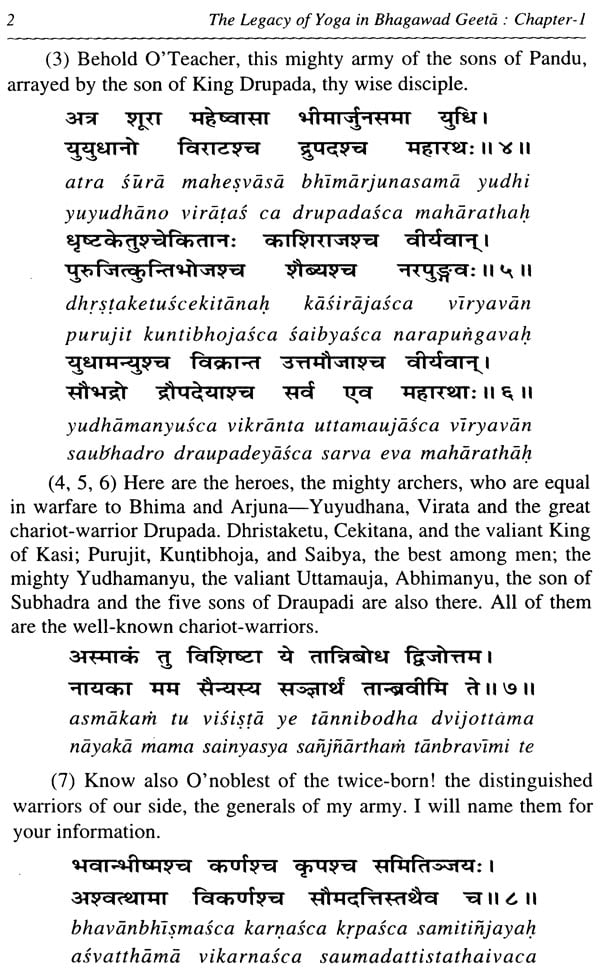
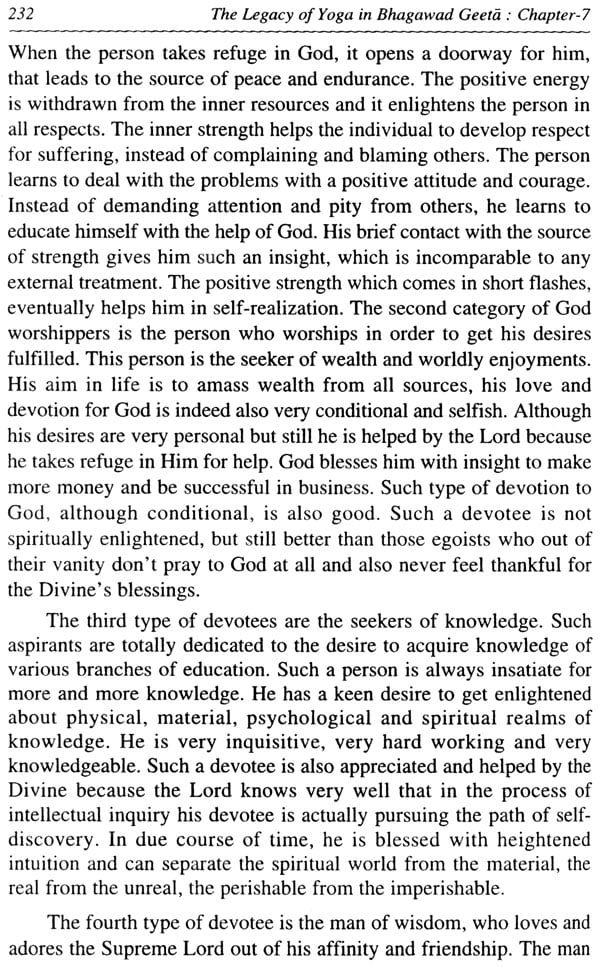
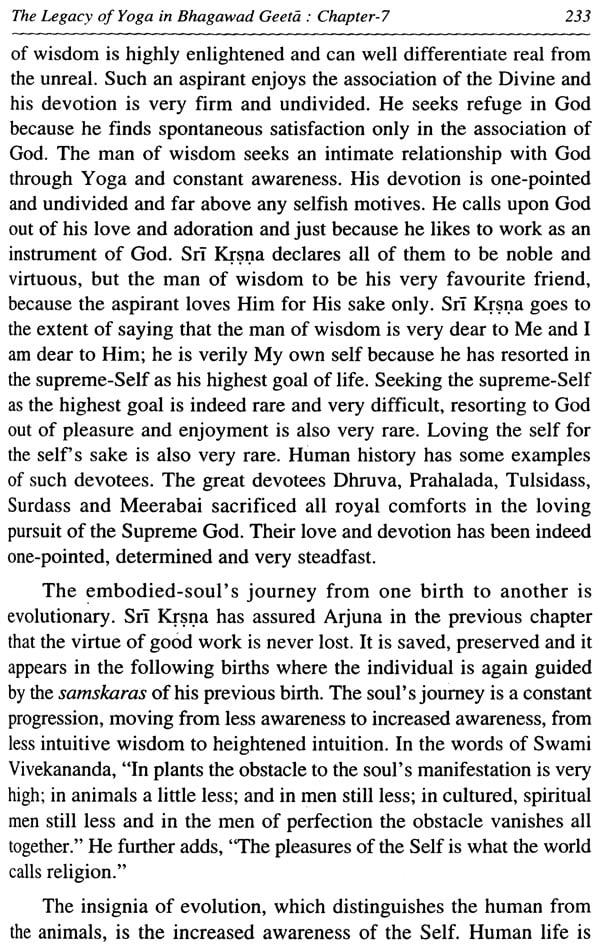
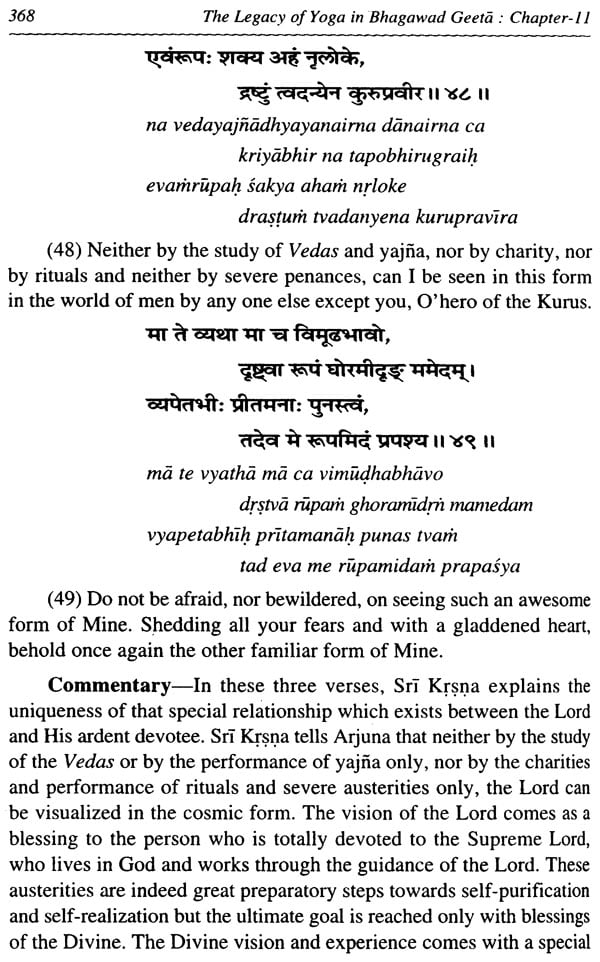
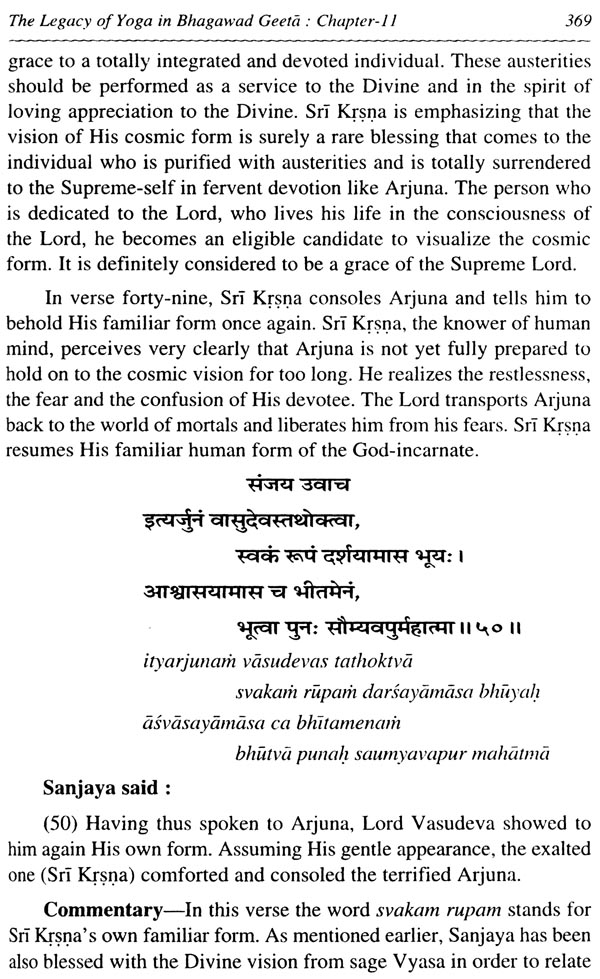
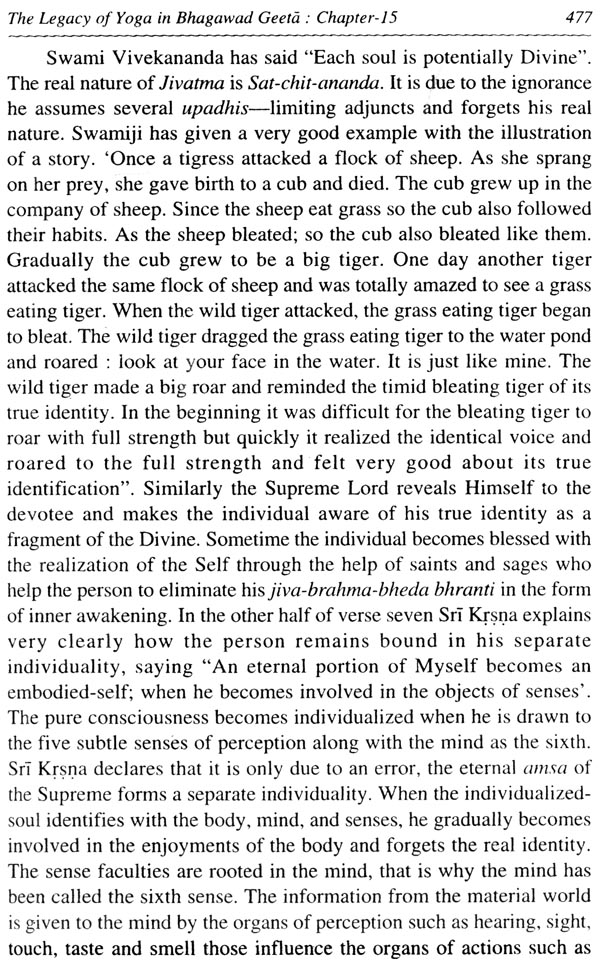
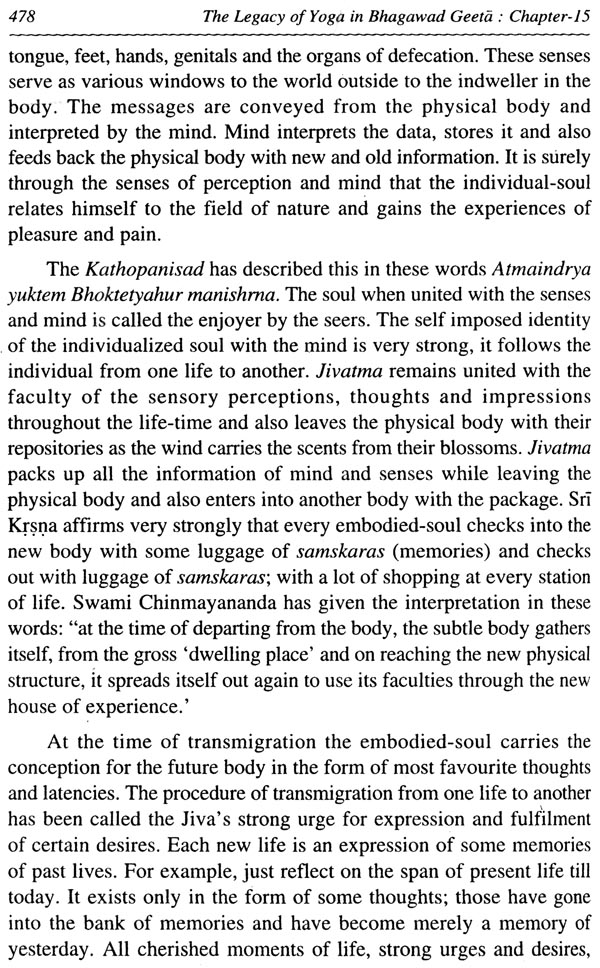
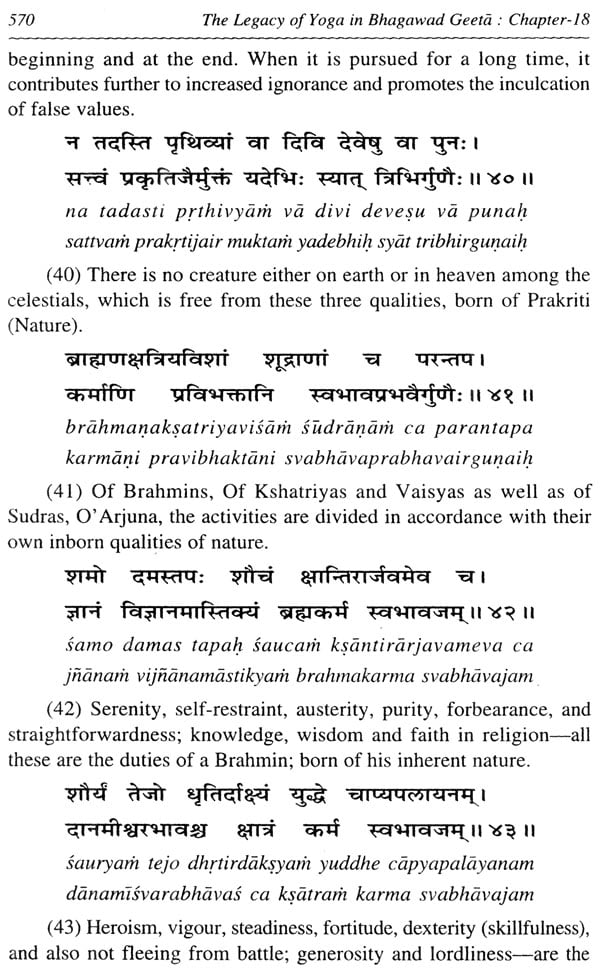
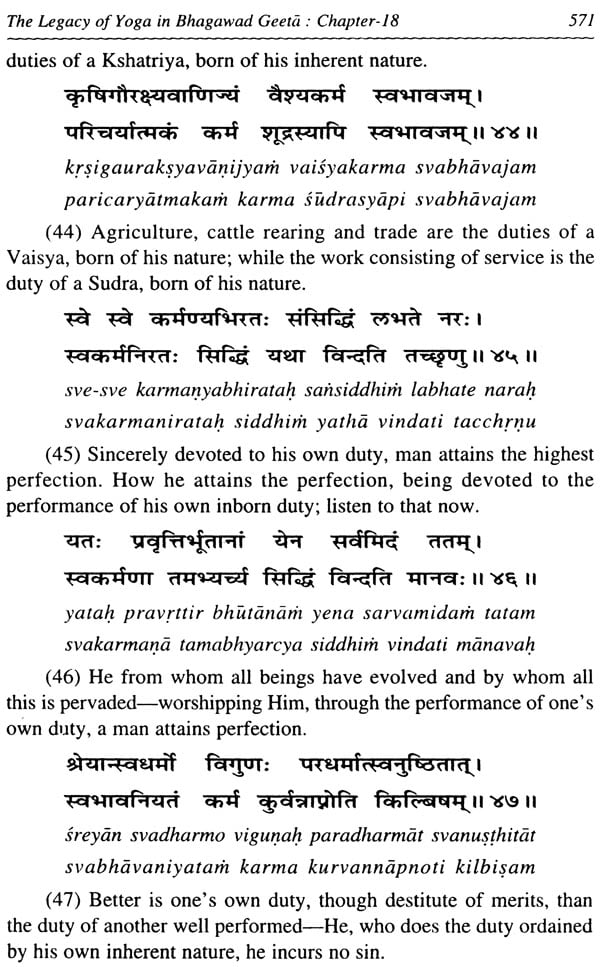
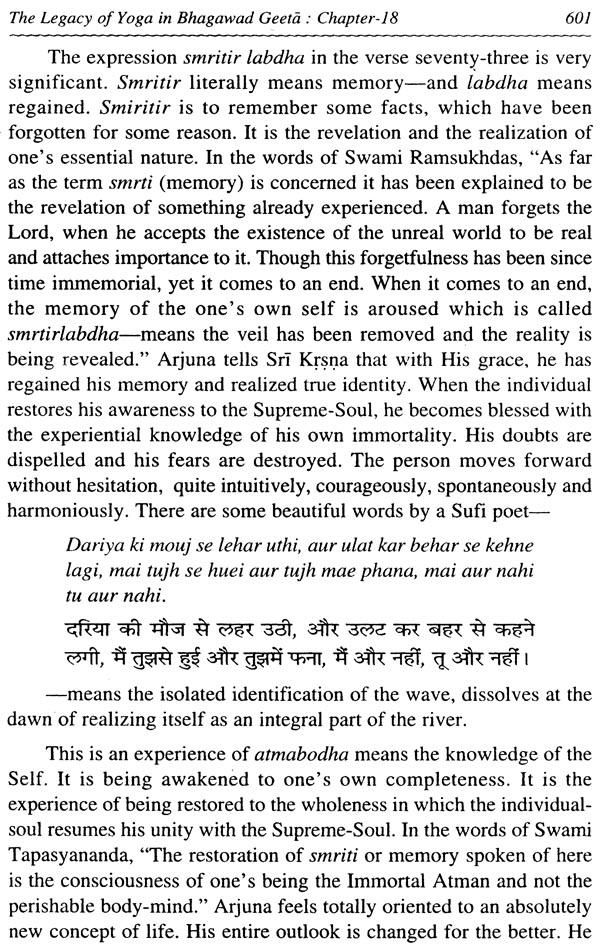
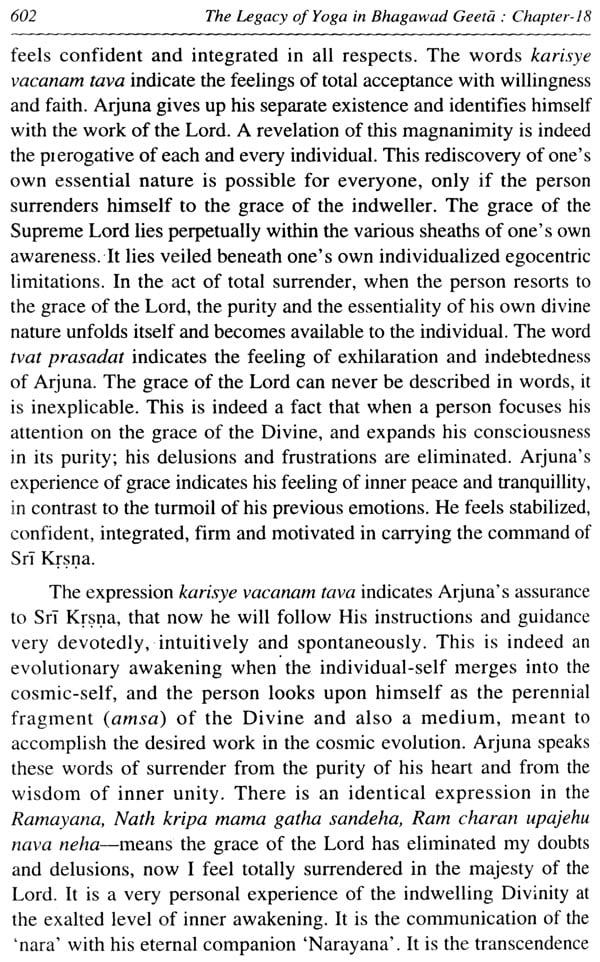
Delivery and Shipping Policy
- INTERNATIONAL SHIPPING
- Rs.1000-1100/kg
- ESTD. Delivery Time: 2-3 weeks (depending on location)
- Bubble Wrapped with Extra Padding
- NATIONAL SHIPPING
- NCR: Rs. 30/half kg
- Standard: Rs. 80/half kg
- Express shipments also available on Request
- ESTD. Delivery Time: Ranging from 1-4 days up to 7 business days (Depending on your choice of Delivery)
- TRACKING
- All orders; national or international, will be provided with a Tracking ID to check the status of their respective orders
- Depending on the Shipping Service, Tracking ID may be used on their respective tracking portals
Frequently Asked Questions (FAQs)
Domestic Shipping: 3-4 Days (after shipping)
International Shipping: 1-2 weeks (based on your location)
You will receive an email once your order has been shipped or you can email us if you didn't receive tracking details (info@mlbd.co.in)
Every book that we sell is the latest edition except all the rare books
Yes, we do provide free shipping, only on domestic orders (within India) above Rs.1500


